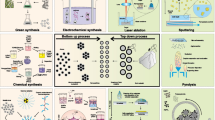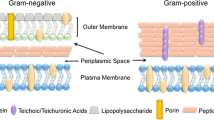Abstract
Reactive oxygen species (ROS) are involved in drug-induced cytotoxicity by regulating cell signaling, inducing oxidative stress, and damaging the DNA and proteins. Examining ROS production in cells under the stimulation of chemotherapeutic drugs is of great importance for understanding the ROS roles and identifying the mechanism of drug-induced cytotoxicity. Here, a silver/gold (Ag/Au) nanoshell-based colorimetric and surface-enhanced Raman spectroscopy (SERS) dual-response nanoprobe was proposed for ROS sensing on the basis of Ag etching. In this study, as a kind of ROS, hydrogen peroxide (H2O2) was detected by the prepared nanoprobe. The linear ranges of 0.5–100 μM with a limit of detection (LOD) of 0.343 μM for the colorimetric determination and 1–50 μM with LOD of 0.294 μM for SERS determination were achieved. The detection of cellular ROS concentration after stimulation by cisplatin, paclitaxel, doxorubicin, and 5-fluorouracil was validated by the nanoprobe. The nanoprobe could also be used to detect the signal pathway of ROS production by cisplatin stimulation. This study provided a simple and novel dual-response nanoplatform for detecting and monitoring ROS in cells, which holds great potential for elucidating the mechanism of occurrence and treatment of ROS-involved diseases.
Graphical abstract








Similar content being viewed by others
References
Scherlinger M, Tsokos G (2021) Reactive oxygen species: the Yin and Yang in (auto-) immunity. Autoimmun Rev 20(8):102869
Sies H, Jones D (2020) Reactive oxygen species (ROS) as pleiotropic physiological signalling agents. Nat Rev Mol Cell Biol 21(7):363–383
Kirtonia A, Sethi G, Garg M (2020) The multifaceted role of reactive oxygen species in tumorigenesis. Cel Mol Life Sci 77(22):4459–4483
Mailloux R (2020) An update on mitochondrial reactive oxygen species production. Antioxidants 9(6):472
Thiruppathi M, Lin P, Chou Y (2019) Simple aminophenol-based electrochemical probes for non-enzymatic, dual amperometric detection of NADH and hydrogen peroxide. Talanta 200:450–457
Yang W, Weng C, Li X, He H, Fei J, Xu W, Yan X, Zhu W, Zhang H, Zhou X (2021) A sensitive colorimetric sensor based on one-pot preparation of h-Fe3O4@ppy with high peroxidase-like activity for determination of glutathione and H2O2. Sens Actuators B Chem 338:129844
Qiao X, Gao Y, Zheng L, Ding X, Xu L, Hu J, Gao W, Xu J (2021) Targeting ROS-AMPK pathway by multiaction platinum(IV) prodrugs containing hypolipidemic drug bezafibrate. Eur J Med Chem 223:113730
Yang B, Zhou S, Zeng J, Zhang L, Zhang R, Liang K, Xie L, Shao B, Song S, Huang G, Zhao D, Chen P, Kong B (2020) Super-assembled core-shell mesoporous silica-metal-phenolic network nanoparticles for combinatorial photothermal therapy and chemotherapy. Nano Res 13(4):1013–1019
Liu X, Liu Y, Guo Y, Shi W, Sun Y, He Z, Shen Y, Zhang X, Xiao H, Ge D (2021) Metabolizable pH/H2O2 dual-responsive conductive polymer nanoparticles for safe and precise chemo-photothermal therapy. Biomaterials 277:121115
Shueng P, Yu L, Chiu H, Chang H, Chiu Y, Kuo T, Yen Y, Lo C (2021) Early phago-/endosomal escape of platinum drugs via ROS-responsive micelles for dual cancer chemo/immunotherapy. Biomaterials 276:121012
Hadzic T, Aykin N, Zhu Y, Coleman M, Leick G, Spitz D (2010) Paclitaxel combined with inhibitors of glucose and hydroperoxide metabolism enhances breast cancer cell killing via H2O2-mediated oxidative stress. Free Radical Biol Med 48(8):1024–1033
Fiore L, Mazzaracchio V, Galloni P, Sabuzi F, Pezzola S, Matteucci G, Moscone D, Arduini F (2021) A paper-based electrochemical sensor for H2O2 detection in aerosol phase: measure of H2O2 nebulized by a reconverted ultrasonic aroma diffuser as a case of study. Microchem J 166:106249
Zhou Z, Yang L, Huang L, Liao Y, Liu Y, Xiao Q (2020) A novel fluorescent probe for H2O2 detection based on CdSe@ZnS quantum dots/Ag nanocluster hybrid. Anal Chim Acta 1106:176–182
Teodoro K, Migliorini F, Christinelli W, Correa D (2019) Detection of hydrogen peroxide (H2O2) using a colorimetric sensor based on cellulose nanowhiskers and silver nanoparticles. Carbohydr Polym 212:235–241
Shen Y, Liang L, Zhang J, Li Z, Yue J, Wang J, Xu W, Shi W, Xu S (2019) Interference-free surface-enhanced Raman scattering nanosensor for imaging and dynamic monitoring of reactive oxygen species in mitochondria during photothermal therapy. Sens Actuators B Chem 285:84–91
Lee D, Kang S, Lee Y, Kim J, Yoo D, Jung W, Lee S, Jeong Y, Lee K, Jon S (2020) PEGylated bilirubin-coated iron oxide nanoparticles as a biosensor for magnetic relaxation switching-based ROS detection in whole blood. Theranostics 10(5):1997
Lv W, Cao M, Liu J, Hei Y, Bai J (2021) Tumor microenvironment-responsive nanozymes achieve photothermal-enhanced multiple catalysis against tumor hypoxia. Acta Biomater 135:617–627
Hou J, Jia P, Yang K, Bu T, Sun X, Wang L (2021) Facile preparation of Ru@V2O4 nanowires exhibiting excellent tetra-enzyme mimetic activities for sensitive colorimetric H2O2 and cysteine sensing. Sens Actuators B Chem 344:130266
Yuan C, Qin X, Xu Y, Jing Q, Shi R, Wang Y (2020) High sensitivity detection of H2O2 and glucose based on carbon quantum dots-catalyzed 3, 3′, 5, 5′-tetramethylbenzidine oxidation. Microchem J 159:105365
Li C, Song M, Wu S, Wang Z, Duan N (2023) Selection of aptamer targeting levamisole and development of a colorimetric and SERS dual-mode aptasensor based on AuNPs/Cu-TCPP(Fe) nanosheets. Talanta 251:123739.
Hu F, Li Y, Zhang Y, Li Y, Li H, Ai S (2020) Flexible Ag NCs/CNFs film for colorimetric and SERS dual-mode ultrasensitive detection of mercury ions (II). Vib Spectrosc 118:103342
Liu S, Huo Y, Deng S, Li G, Li S, Huang L, Ren S, Gao Z (2022) A facile dual-mode aptasensor based on AuNPs@MIL-101 nanohybrids for ultrasensitive fluorescence and surface-enhanced Raman spectroscopy detection of tetrodotoxin. Biosens Bioelectron 201:113891
Zhu J, Wang M, Tu L, Wang A, Luo X, Mei L, Zhao T, Feng J (2021) Nanosheets-assembled hollow CdIn2S4 microspheres-based photoelectrochemical and fluorescent dual-mode aptasensor for highly sensitive assay of 17β-estradiol based on magnetic separation and enzyme catalytic amplification. Sens Actuators B Chem 347:130553
Huang Y, Gu Y, Liu X, Deng T, Dai S, Qu J, Yang G, Qu L (2022) Reusable ring-like Fe3O4/Au nanozymes with enhanced peroxidase-like activities for colorimetric-SERS dual-mode sensing of biomolecules in human blood. Biosens Bioelectron 209:114253
Poudel B, Gupta B, Ramasamy T, Thapa R, Pathak S, Oh K, Jeong J, Choi H, Yong C, Kim J (2017) PEGylated thermosensitive lipid-coated hollow gold nanoshells for effective combinational chemo-photothermal therapy of pancreatic cancer. Colloids Surf B 160:73–83
Zhang H, Lin X, Wang A, Zhao Y, Chu H (2015) Fluorescence enhancement of europium complexes by core–shell Ag@SiO2 nanoparticles. Spectrochim Acta Part A 151:716–722
Ha P, Vu X, Dien N, Trang T, Van T, Thanh T, Tan P, Ca N (2020) The structural transition of bimetallic Ag-Au from core/shell to alloy and SERS application. RSC Adv 10(41):24577–24594
Liu S, Mo S, Han L, Li N, Fan Y, Li N, Luo H (2019) Oxidation etching induced dual-signal response of carbon dots/silver nanoparticles system for ratiometric optical sensing of H2O2 and H2O2-related bioanalysis. Anal Chim Acta 1055:81–89
Scroccarello A, Della F, Ferraro G, Fratini E, Tempera F, Dainese E, Compagnone D (2021) Plasmonic active film integrating gold/silver nanostructures for H2O2 readout. Talanta 222:121682
Nair A, Sukumaran N, Thomas S, Rouxel D, Alwarappan S, Kalarikkal N (2018) In situ synthesis of silver nanospheres, nanocubes, and nanowires over boron-doped graphene sheets for surface-enhanced Raman scattering application and enzyme-free detection of hydrogen peroxide. Langmuir 34(45):13603–13614
Kirtonia A, Sethi G, Garg M (2020) The multifaceted role of reactive oxygen species in tumorigenesis. Cell Mol Life Sci 77:4459–4483
Li X, Zhang H, Chan L, Liu C, Chen T (2018) Nutritionally available selenocysteine derivative antagonizes cisplatin-induced toxicity in renal epithelial cells through inhibition of reactive oxygen species-mediated signaling pathways. J Agr Food Chem 66(23):5860–5870
Jiang H, Zhang X, Liao Q, Wu W, Liu Y, Huang W (2019) Electrochemical monitoring of paclitaxel-induced ROS release from mitochondria inside single cells. Small 15(48):1901787
Yang H, Villani R, Wang H, Simpson M, Roberts M, Tang M, Liang X (2018) The role of cellular reactive oxygen species in cancer chemotherapy. J Exp Clin Can Res 37(1):1–10
Wang Z, Gu C, Wang X, Lang Y, Wu Y, Wu X, Zhu X, Wang K, Yang H (2019) Caffeine enhances the anti-tumor effect of 5-fluorouracil via increasing the production of reactive oxygen species in hepatocellular carcinoma. Med Oncol 36(12):1–9
Mailloux R, Gardiner D, Brien M (2016) 2-Oxoglutarate dehydrogenase is a more significant source of O2-/H2O2 than pyruvate dehydrogenase in cardiac and liver tissue. Free Radical Bio Med 97:501–512
Goncalves R, Bunik V, Brand M (2016) Production of superoxide/hydrogen peroxide by the mitochondrial 2-oxoadipate dehydrogenase complex. Free Radical Bio Med 91:247–255
Slade L, Chalker J, Kuksal N, Young A, Gardiner D, Mailloux R (2017) Examination of the superoxide/hydrogen peroxide forming and quenching potential of mouse liver mitochondria. Biochim Biophys 1861(8):1960–1969
Wang Y, Luo X, Pan H, Huang W, Wang X, Wen H, Shen K, Jin B (2015) Pharmacological inhibition of NADPH oxidase protects against cisplatin induced nephrotoxicity in mice by two step mechanism. Food Chem Toxicol 83:251–260
Acknowledgements
We thank Xuerui Fu from Hebei Medical University Core Facilities and Centers for confocal fluorescent measurements.
Funding
This work was supported by the Postdoctoral Fund of Hebei Medical University, Postdoctoral Fund of Hebei Province (B2021003040), the Natural Science Foundation of Hebei Province (Nos. H2020206416, B2021206005, B2019206437), the Youth Top Talent Project of Hebei Province Higher Education (Nos. BJ2021050, BJ2020034), and the Chunyu Project Outstanding Youth Fund of Hebei Medical University (Nos. CYYQ2021003, CYYQ201903).
Author information
Authors and Affiliations
Contributions
MW: methodology, data curation, investigation, software, validation, and writing—original draft preparation. YS: methodology, investigation, data curation, software, and writing—review and editing. XH: data curation, software, and validation. YZ: data curation, software, and validation. JW: conceptualization, visualization, supervision, and writing—review and editing.
Corresponding author
Ethics declarations
Competing interests
The authors declare no competing interests.
Additional information
Publisher's note
Springer Nature remains neutral with regard to jurisdictional claims in published maps and institutional affiliations.
Supplementary Information
Below is the link to the electronic supplementary material.
Rights and permissions
Springer Nature or its licensor holds exclusive rights to this article under a publishing agreement with the author(s) or other rightsholder(s); author self-archiving of the accepted manuscript version of this article is solely governed by the terms of such publishing agreement and applicable law.
About this article
Cite this article
Wang, M., Shen, Y., Hu, X. et al. Colorimetric/SERS dual-channel nanoprobe for reactive oxygen species monitoring in elucidating the mechanism of chemotherapeutic drugs action on cancer cells. Microchim Acta 189, 351 (2022). https://doi.org/10.1007/s00604-022-05451-x
Received:
Accepted:
Published:
DOI: https://doi.org/10.1007/s00604-022-05451-x




